Mike Kelley at K21: A Lobotomy
I knew nothing about this artist walking into this show. Walking out, I despised him. Sitting with myself for a couple days, it clicked.
Meeting the Kelleys
If you say Kelley, I’m asking: Kapoor, the bag, or the family? Prior to my visit to his solo exhibition at Kunstsammlung NRW’s K21 in Düsseldorf, I didn’t know anything about Mike Kelley (1954-2012, American). The show surely sent me on an emotional rollercoaster including disgust, rage, and intrigue, all directed at various parties.
As I descended into the museum’s basement, I was met by noise. Conflicting noise coming from TVs, spinning racks and curtains, bangs and shots and songs. I felt the irritation taking over my body. It was as if somebody started to scrub my brain with sandpaper.
In Mike’s art, everything is all over the place. Curator Falk Wolf (Gen X, German) organized the exhibition in seven sections, spanning Mike’s interest in performance, societal (dis)approval of sexuality, evangelical fanatism, ghosts and occultism, power structures such as education systems including the abuse of power and the role of collective and individual memory, … and Superman… yeah, I know. We’ll get to that later…
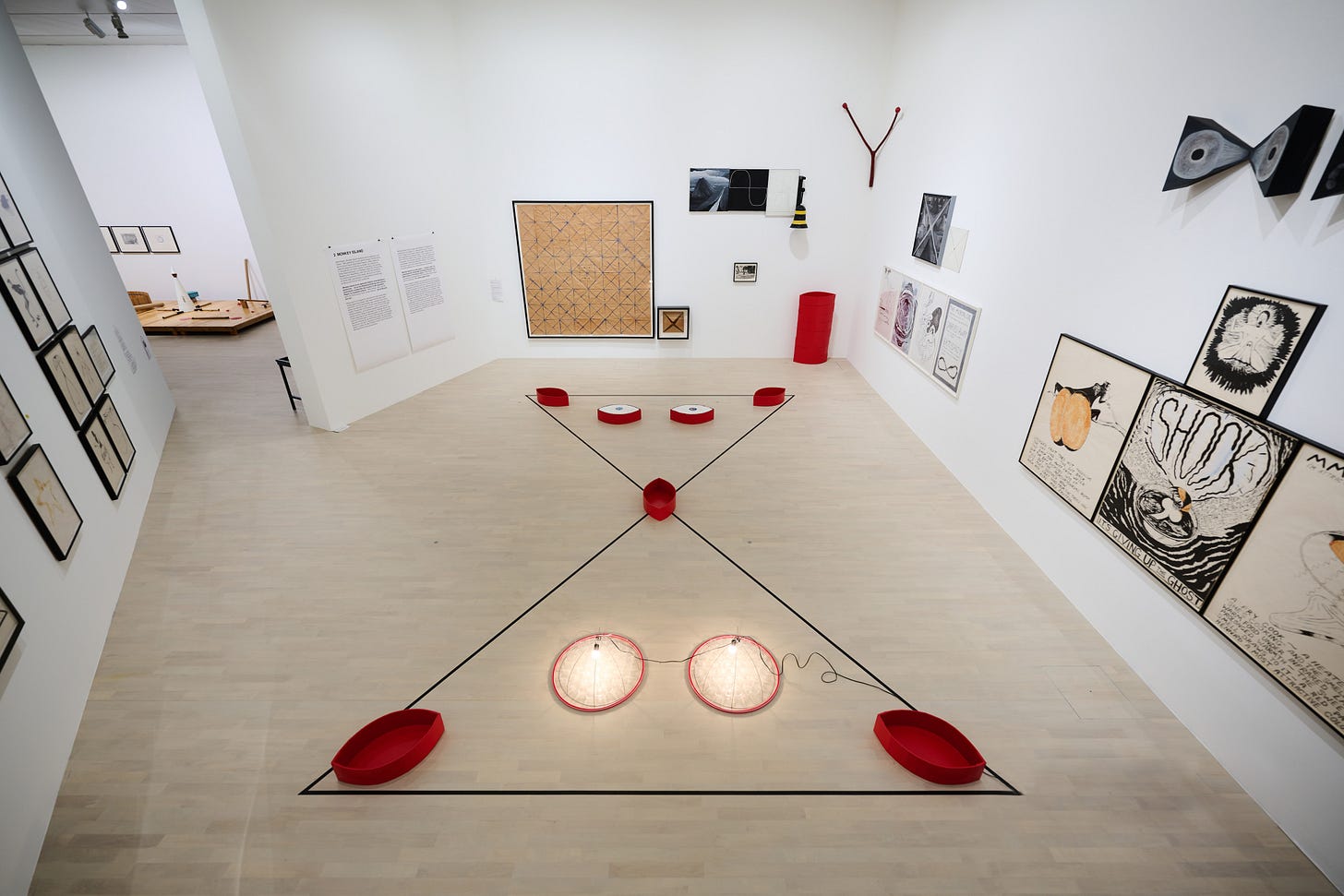
While the press release claims that Mike influenced a whole bunch of artist (without providing the receipts, though), I see him rather being a copycat: His architectural sketches of partly fictional educational facilities as abusive power systems make me think of Joseph Beuys (1921-86, German) chalkboard sketches and diagrams. The two clowns popping up in his Day Is Done (2005) mega-work are kind of Gilbert & George (both Silent Generation, British) coded. And don’t get me started on the Monkey Island (1982-85) series where Mike folds paper and notes opposite terms on each side of the resulting X-form. Babes, Anna Oppermann (1940–1993, German) worked with opposite terminology in the ‘70s already, you’re not that guy…
My jaw dropped when my research brought me to Sarah Charlesworth (1947-2013, American), whose Modern History series of newspaper front-pages with nothing but the pictures left on them happened to be “one of the most frequently discussed bodies of work”1 at CalArts when Mike studied there. And what did Mike do with his Timeless/Authorless series? He kept only the pictures of the newspaper front-pages and rewrote the articles! Naughty, naughty Falk! Don’t be shy to mention female predecessors!
What bothered me with this exhibition is its lack of nuance and interrogation. The texts were written as if unconditionally nodding to Mike’s presupposed genius.
The Question of Truth
[T]he world seemed to me a media facade, and all history a fiction— a pack of lies.
- Mike Kelley, “Cross-Gender/Cross-Genre”, 1999, quote extracted from press release
Mike grew up in Detroit as the youngest kid in a Catholic working class family. His youth was formed by media and the promises of past generations finally crumbling: Work hard and you’ll get a comfortable life! It’s worth dying for your country, because your country is on the right side of history! The government has your best interest in mind!
While many people in the United States experienced disillusionment, Mike came of age in Post-Modernity, the era of what is true anyway? It was also the era of radical religious sects and extremist evangelicalism, movements that were an especially fertile breeding ground for conspiracy theories. Not only does history repeat itself quite dangerously in these aspects, but those are also notions that informed Mike’s practice, eventhough he wasn’t the only artist in his time interested in these issues.
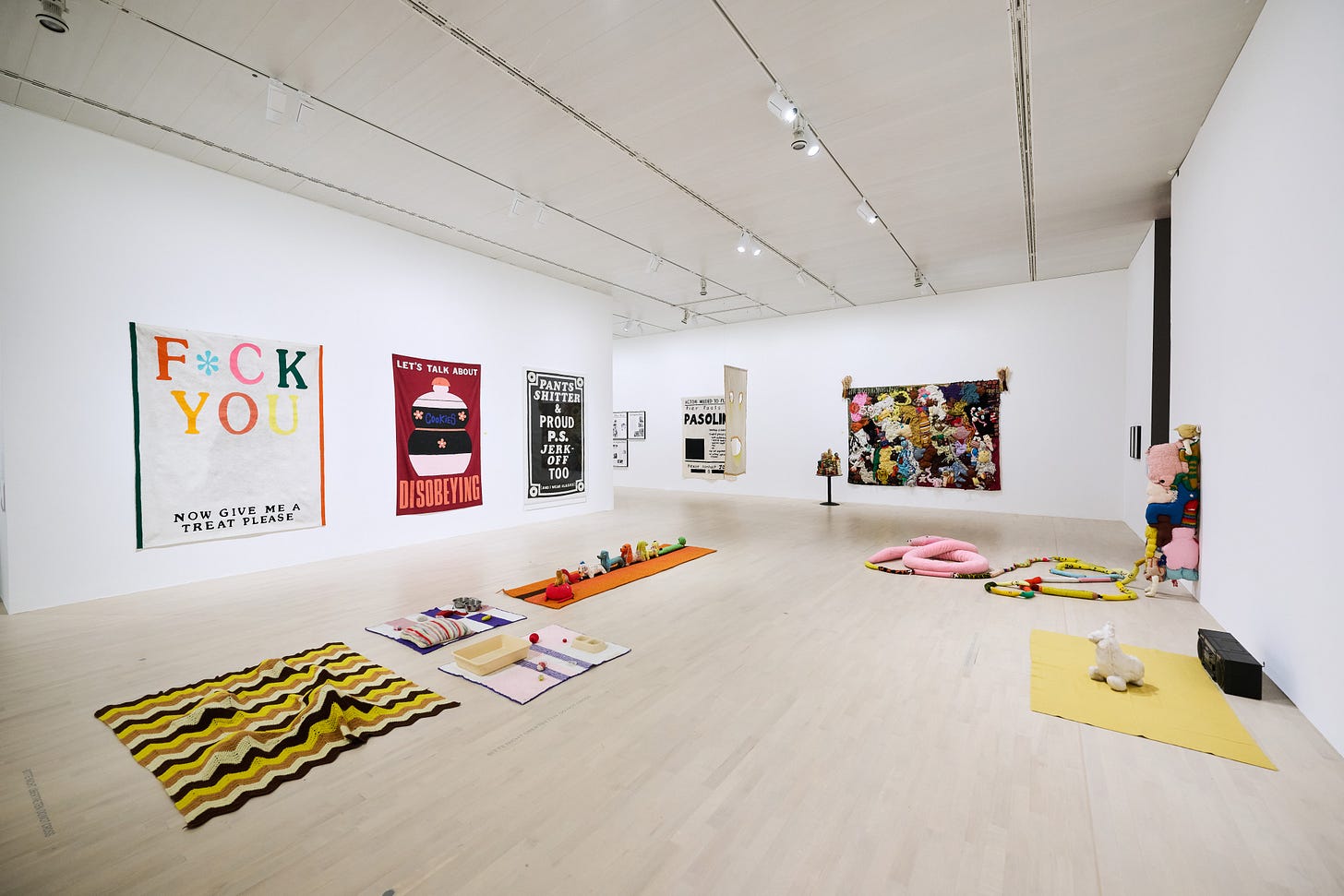
In the 1980s, Mike began using discarded toys in his installations. These new works fell into a period when newspapers were uncovering unprecedented abuse scandals in preschools and nurseries (Falk forgot to mention this teeny tiny but crucial detail in the corresponding wall text).2 People (legitimately) interpreted Mike’s pieces as comments on child abuse. Reacting to this angle, Mike started to explicitly engage with abuse in his art.
While Falk gets a lot of heat on this review, I need to put Mike on trial, too. Of course I’d find it unreasonable to make the jump from children’s toy to sexual abuse in every single work, don’t get me wrong, but some of Mike’s display disturbingly sexual connotations I can’t and won’t shrug off. One piece consists of used toys, fluffy teddy bears and other plushy cuties, sewn together on one large tableau. The title of this 1987 work is More Love Hours Than Can Ever Be Repaid and the Wages of Sin… PAUSE. Why would the words “love hours” and “sin” be anywhere near a child?
You’re right, Michael. How does one even jump to such an absurd conclusion when seeing phallic bananas coming out the monumentally enlarged frontal body opening of a female doll? Silly me for misinterpreting Eviscerated Corpse (1989), duh! Mike looks to me like the type of guy who’ll get caught in 4K and say “Do you believe me or your lying eyes?”
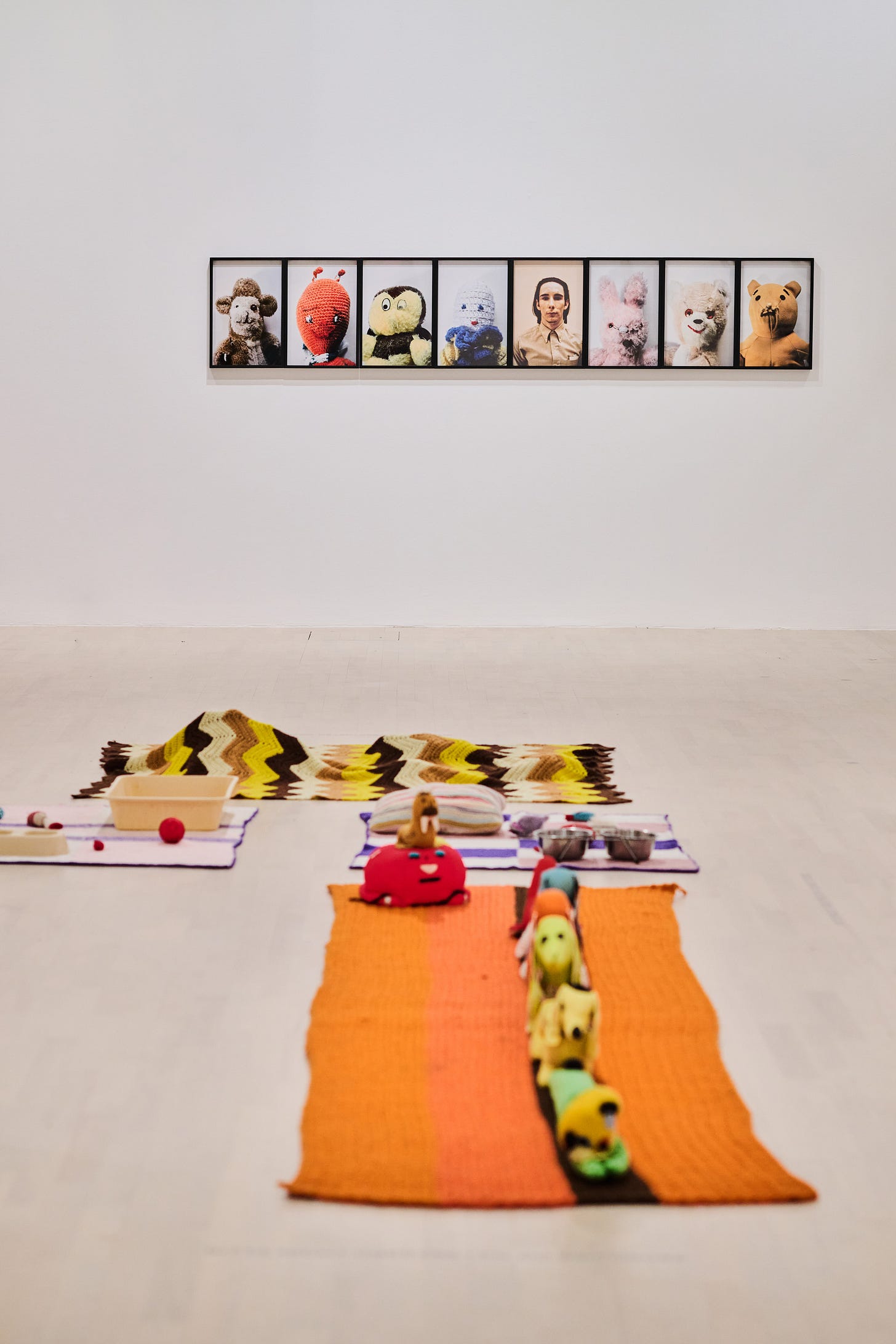
The worst ones: Manipulating Mass-Produced Idealized Objects (1990) and Nostalgic Depiction of the Innocence of Childhood (1990/2008), two photographs depicting performance artists Bob Flanagan (1952-96, American) and Sheree Rose (Silent Generation, American) rubbing their naked bodies against children’s toys… that once belonged to children… and carry the traces of those children… and now these once favorite companions are forcibly turned into participants of this performance “where adults […] imagine how children would behave when exploring their own bodies”, according to the wall label. How is this “a defense of childhood against the classifications and conformations of adults”, as the label puts it, when adults base a performance on imagining children exploring their bodies? Like… that shouldn’t be on their mind in the first place? And how does it help to force viewers into imagining children performing these actions? It’s especially weird given sadomasochism was part of Bobby’s and Sheree’s artistic practice and personal life.
I know, I know, artistic freedom this, provocation as commentary that, societal critique whatever. And still, this work and its method doesn’t sit right with me. Mike sure can claim artistic freedom for himself, but Kunstsammlung NRW as an institution can’t. So even if Falk decided that these two photographs are provocative and not predatory, he better have some good reasoning. And “[w]hat may seem perverse at first glance is in fact a defense of childhood” is probably the most brainrotten of all possible explanations.
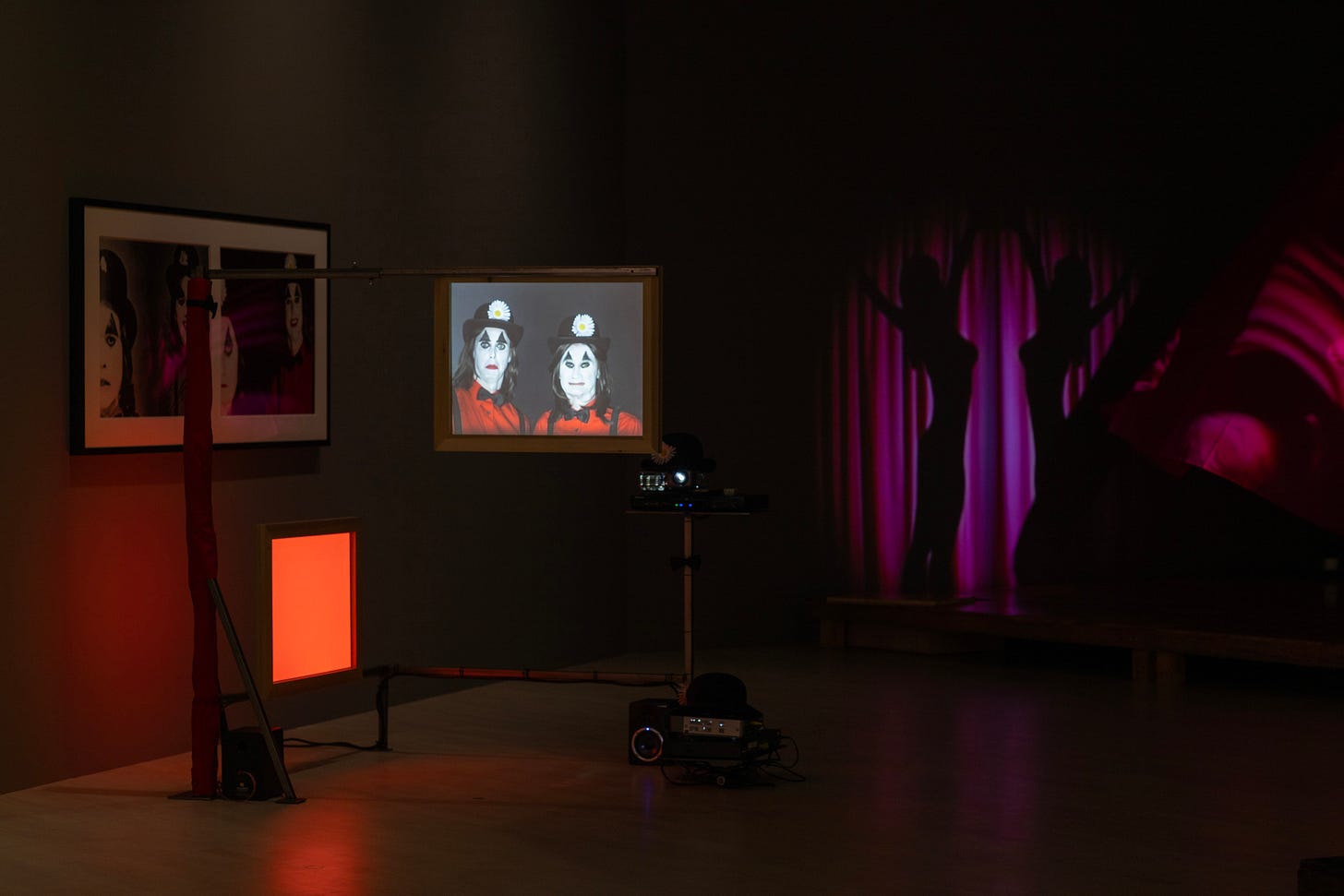
Given that you guys decided it would be appropriate to launch a capsule wardrobe featuring Mike’s most instagrammable artworks, I think partnering with 032c might not have been the best choice. I would have recommended a brand that, just like Mike, laid out how “it was never our intent to include [child abuse] in our narrative”. You could draw some inspiration from their 2022 Holiday Campaign and tie a connection back to Mike’s fascination with conspiracies, I’m sure he would have loved it!
When History Repeats Itself
Curatorially, Falk fails to build a bridge to the present. In 1995, Mike reacted to being “accused of having experienced abuse”… I don’t even know how accusing someone of being a victim works — oh, right, victim blaming —, but that’s how the exhibition text put it without further elaboration. The result was Mike’s earlier mentioned Timeless/Authorless series, where he rewrote newspaper articles, blacking parts out, “some of the texts describ[ing] invented fantasies of violence and abuse”.
The way this work is presented in the show lacks sensitivity for the current political climate. With more and more people distrusting investigative media and fake news being used by politicians to radicalize masses, I see how in a world of QAnon, 4Chan and red pill-Reddit, a very dangerous group could resonate with Mike’s provocation that there is no truth. But what differentiates the provocative artist from the troll anyway?
Another horribly framed aspect of Mike’s work is his idea for Day Is Done, which he wanted to be “a contemporary gesamtkunstwerk that is not utopian in nature but is an extension of our current victim culture.” PAUSE. If Mike’s work is such a poignant observation of his post-modern society, how comes the curator seems to have no sensibility for our time and age right now? Because if Falk did, he would be aware of the current radicalization of misogynistic young men and he would also know that “victim culture” is an umbrella-term used by incels to discredit calls to structural equity. But I guess that there’s no spare time to actually go see what’s going on out there in the world when you’re busy all day making an exhibition about what’s going on out there in the world.
The Super Irrelevant Saga
One spacious room is reserved for Mike’s interest in Superman which he extensively worked with in his Kandors (1999–2011) series. This room is probably the most instagrammable one in the show, but thanks God that’s not a criterion that museums put above content when curating exhibitions, am I right guys? Um, right…?
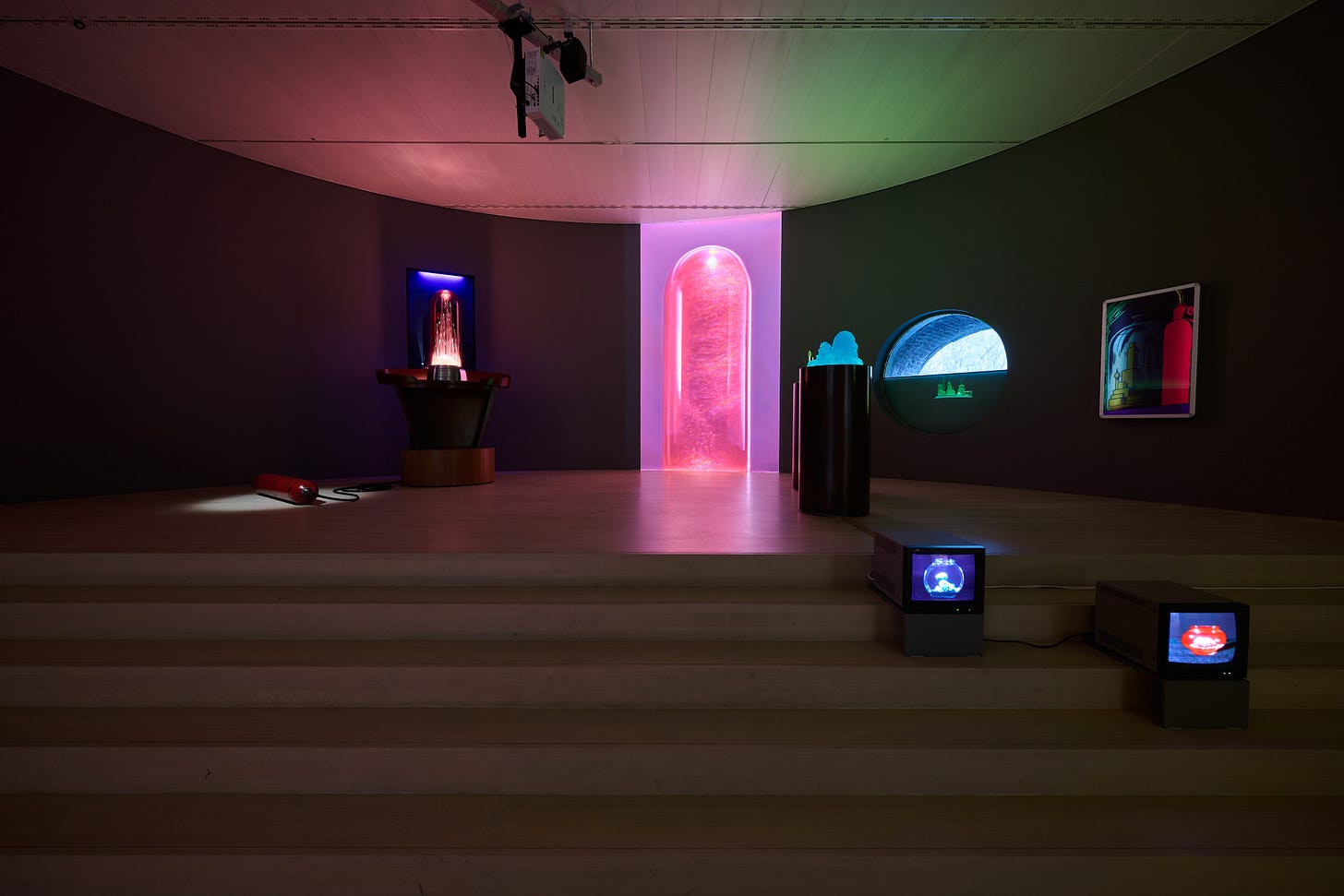
Like that’s cute that you like Superman so much. Why would I care though? I know that Superman is a pop cultural icon and historically shaped visions of heroism and masculinity in the United States and beyond. That could have been an interesting point of investigation. But Mike isn’t working with that. It’s literally just the attempt to reconstruct Kandor, Superman’s home city from all the different versions and angles in the comics… The end. Put this into Comic Con and everybody will be happy. Mike is not afraid to talk about himself, and isn’t that a refreshing quality in a man?
Where Irony and Entitlement Meet
Speaking of the exhibition title Ghost and Spirit, I first thought that the title doesn’t really fit the show. But as I contemplated it some more, Kunstsammlung NRW, along with the other institutions involved in this show, really did sell their souls to hype. And it started way before Mike.
Even if Mike did not intend his works to be about abuse initially, abuse is all around this institution. For this show, they kept the exhibition design by Adjaye Associates, the architecture company that designed the room initially for the Isaac Julien (Baby Boomer, British) show last year. Adjaye Associates is headed by Sir David Adjaye (Gen X, British). You know, the star architect whom several women accused of sexual misconduct since last summer. Given that Isaac’s show was in October, there’s no way they could not have known. What an irony. But I guess when it comes down to the core, nobody really cares in the arts once money is involved and time is scarce.
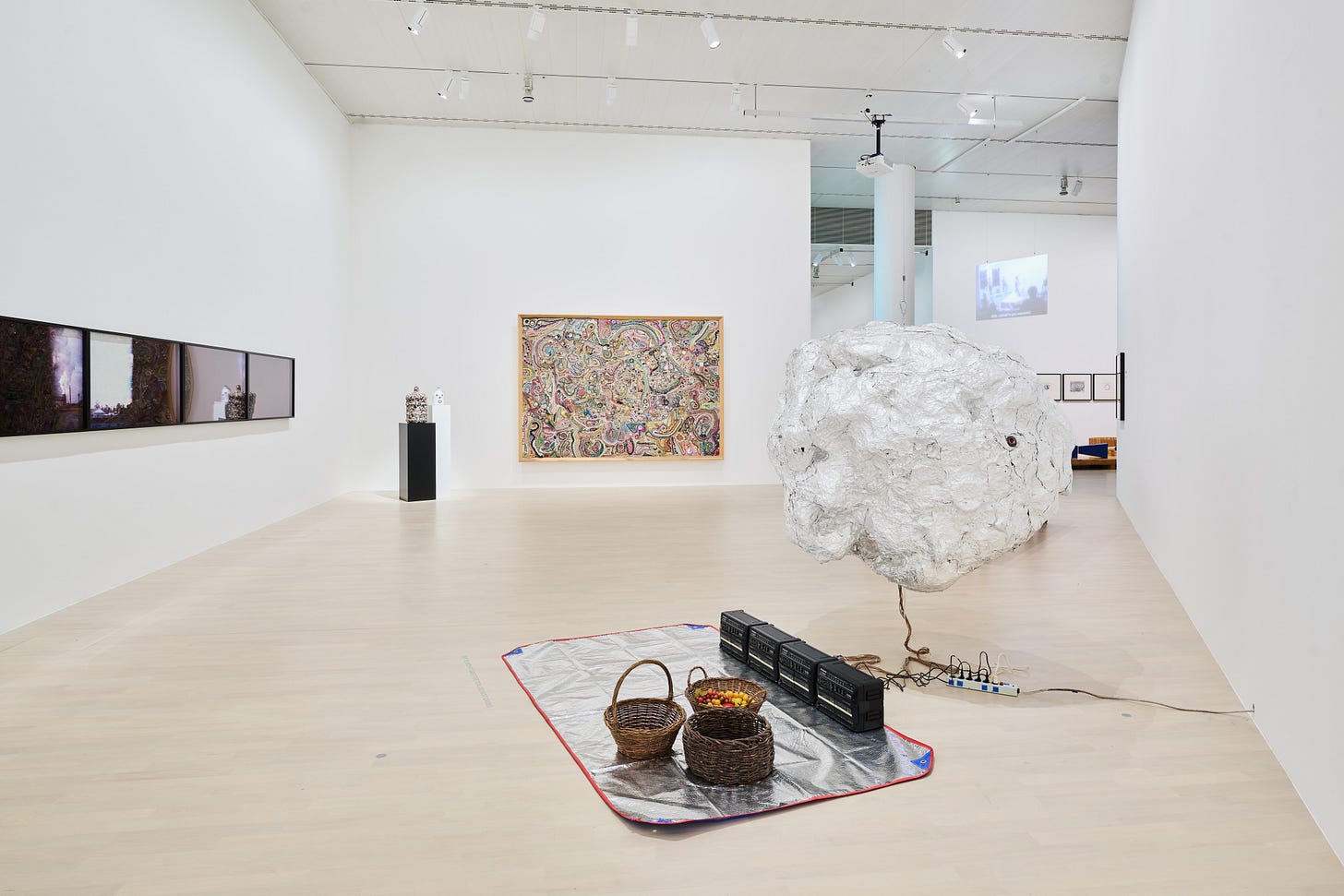
With Isaac Julien, Mike Kelley, and Lars Eidinger (Gen X, German), K21 shows not only three male artists in a row but goes from chef’s kiss to gentrified Rave to amateur photographer who isn’t even an artist. Dear Kunstsammlung NRW, I don’t know if nobody told you lately, and I’ll hold your hand while I say this: You don’t have to sacrifice institutional integrity for reach and popularity. Because if you do, it means that you don’t believe in good art being a reason in itself to keep going.
I’d like to end this review with the words of Jenny Holzer (Baby Boomer, American), who exhibited in this very same building last year, typing out her words that hold truth for as long as time exists: Abuse of power comes as no surprise.
If you’re down with getting the last of your nerves wrecked, you can pass by Mike Kelley: Ghost and Spirit through September 8, 2024.
Kunstsammlung NRW - K21
Ständehausstraße 1
40217 Düsseldorf
Website
Instagram: @kunstsammlungnrw @mike_kelley_foundation
That was a draining one. I hope my next review gets to be a lighter one again. What do you think? Please leave me your thoughts in the comments. As a subscriber, you can also like my posts which helps me a lot with gaining reach. And don’t forget to subscribe and share!
See you soon!!!
Jennifer
The Gen Z Art Critic
Douglas Eklund: “The Artist As Researcher” in: Everything is Connected. Art and Conspiracy. Ex.-Cat. Met Museum, New York 2018, p. 50.
Ian Alteveer: “Extraterrestrials Underground And Other Artistic Sublevels In California” in: Everything is Connected. Art and Conspiracy. Ex.-Cat. Met Museum, New York 2018, p. 115.




